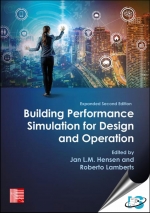Tab Article
When used appropriately, building performance simulation has the potential to reduce the environmental impact of the built environment, to improve indoor quality and productivity, as well as to facilitate future innovation and technological progress in construction. Since publication of the first edition of Building Performance Simulation for Design and Operation, the discussion has shifted from a focus on software features to a new agenda, which centres on the effectiveness of building performance simulation in building life cycle processes.
This new edition provides a unique and comprehensive overview of building performance simulation for the complete building life cycle from conception to demolition, and from a single building to district level. It contains new chapters on building information modelling, occupant behaviour modelling, urban physics modelling, urban building energy modelling and renewable energy systems modelling. This new edition keeps the same chapter structure throughout including learning objectives, chapter summaries and assignments. Moreover, the book:
- Provides unique insights into the techniques of building performance modelling and simulation and their application to performance-based design and operation of buildings and the systems which service them.
- Provides readers with the essential concepts of computational support of performance-based design and operation.
- Provides examples of how to use building simulation techniques for practical design, management and operation, their limitations and future direction.
It is primarily intended for building and systems designers and operators, and postgraduate architectural, environmental or mechanical engineering students.


